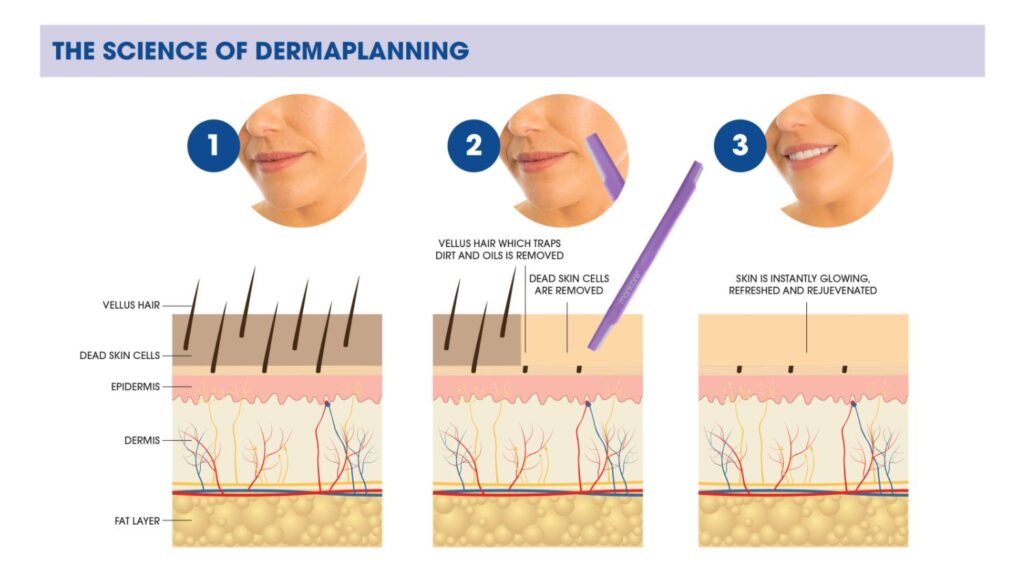If you’re looking for a minimally invasive way to rejuvenate your skin and give it the kickstart it needs to look brighter and healthier, dermaplaning may be able to help. During this procedure, our healthcare providers use a special tool to shave away the topmost layers of your skin, leaving fresh, undamaged skin at the surface. Read on to learn about the procedure’s benefits, how the procedure is done, and what you should consider if you decide to get the procedure done, or contact us if you’d like to schedule a consultation.

Benefits of Dermaplaning
Dermaplaning can have a huge impact on your skin’s tone and texture. There are several benefits of removing the damaged layers on the top of your skin. One is that having a fresh layer of skin at the surface means that your skin will be able to better absorb skincare products. Wrinkles and lines will also be less noticeable after dermaplaning. Additionally, if you wear makeup, dermaplaning can help refresh the skin and make it easier to apply makeup. Many people who suffer from acne scars also find that this procedure can greatly improve the appearance of such scars and improve self-esteem.
How Dermaplaning Works
There are three types of healthcare providers who can perform dermaplaning: a plastic surgeon, a dermatologist, or a cosmetologist. Whoever does your procedure, your journey should begin with discussing your goals with your provider. Your provider will help determine if your skin is healthy enough for the procedure. Skin with open wounds or active acne breakouts are not typically eligible for dermaplaning.
Before the actual procedure, your healthcare providers may provide a local anesthetic like a numbing cream or spray, but general anesthesia is not typically used or needed. You can expect to feel a scratching or stinging sensation, but the procedure isn’t typically painful.
There are two ways that dermaplaning can be performed. One is with an instrument called a dermatome, which is a device used by your provider during the procedure that resembles an electric razor. The device has a small blade that moves back and forth over your skin as it carefully shaves off the top layers. Alternatively, your healthcare provider may use a more manual method by simply using a surgical scalpel to shave off dead layers of skin.
After the procedure is done, most providers will apply a soothing gel or ointment to prevent or limit swelling and irritation. Depending on the size of the area being worked on, this procedure can take anywhere from a couple of minutes to an hour and a half to complete. It is very important that you find a trusted provider to perform this procedure.

Is Dermaplaning Safe?
As with any medical procedure, there are always risks. However, dermaplaning is generally considered a mild and safe cosmetic procedure. Risks involved with the procedure could include infection, keloid or hypertrophic scarring, or skin discoloration. Redness, swelling, and light bruising may occur but should subside within a few days of your procedure.
Dermaplaning Aftercare
Given the nature of the procedure, you should be prepared for your new skin to be sensitive and vulnerable for three days to a week after the procedure. However, there are a couple of important guidelines to keep in mind after having dermaplaning:
- Avoid direct sunlight and extreme heat for 3 days
- Do not exfoliate or scrub the area for 1 week
- Avoid chlorine exposure to the treated area for 1 week
- Apply serums and moisturizers
- Use sunscreen
Always be sure to follow your medical professional’s advice regarding caring for your skin after dermaplaning. Your provider may also recommend specific products for your aftercare.
How to Maintain Dermaplaning Results
Every person’s skin regenerates at a different rate. Therefore, some people may need or want dermaplaning to be redone sooner than others. Generally, patients find that once-a-month sessions help to make the most of their results. If you have particularly sensitive or damaged skin, you may want to space your appointments further out at around six weeks apart. Your provider will be able to give you the best recommendation for treatment frequency.
Combining Dermaplaning with Other Treatments
Dermaplaning can be complemented with other treatments like hydrating facials, laser treatments, microneedling, and microdermabrasion. However, many people choose to get dermaplaning and follow it up with a chemical peel. Since dead skin and hair are removed during dermaplaning, this creates a nice clean slate for a chemical peel to absorb into your skin, making it more effective.
Dermaplaning Compared to Other Exfoliation Methods
Dermaplaning is considered a deep exfoliation procedure. There are, of course, other treatments similar to dermaplaning. Similar procedures can include dermabrasion and microdermabrasion. Dermabrasion is a surgical procedure similar to dermaplaning, except it uses a brush or diamond wheel instead of a sharp blade to remove the top layers of skin. Microdermabrasion is a non-surgical procedure that uses exfoliating scrubs and diamond suctioning tools to remove the skin. However, dermaplaning is often the preferred method, as it is appropriate for more skin types, including sensitive skin.

Determining Your Dermaplaning Eligibility
Many of our patients feel that dermaplaning is an ideal skin treatment, given that it offers fast results with very little recovery time. It’s also ideal for patients who want to avoid chemical-based treatments due to the nature of their skin or personal preferences.
The cost of dermaplaning depends on your needs, skin type, and how large of an area you intend on having treated. It is a very safe and effective procedure that will help you give your skin the fresh start it needs. Our experienced providers can help you determine what the best course of treatment is for you and your needs. Contact us to schedule a consultation today for your next dermaplaning session.




